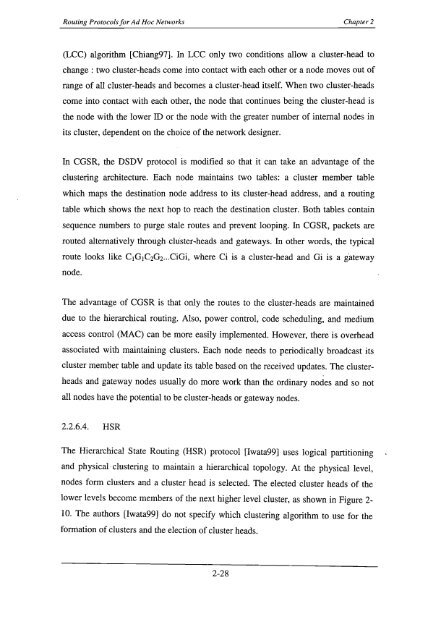Gugrajah_Yuvaan_ Ramesh_2003.pdf
Gugrajah_Yuvaan_ Ramesh_2003.pdf
Gugrajah_Yuvaan_ Ramesh_2003.pdf
You also want an ePaper? Increase the reach of your titles
YUMPU automatically turns print PDFs into web optimized ePapers that Google loves.
Routing Protocols for Ad Hoc Networks Chapter 2<br />
(LCC) algorithm [Chiang97]. In LCC only two conditions allow a cluster-head to<br />
change: two cluster-heads come into contact with each other or a node moves out of<br />
range of all cluster-heads and becomes a cluster-head itself. When two cluster-heads<br />
come into contact with each other, the node that continues being the cluster-head is<br />
the node with the lower ID or the node with the greater number of internal nodes in<br />
its cluster, dependent on the choice of the network designer.<br />
In CGSR, the DSDV protocol is modified so that it can take an advantage of the<br />
clustering architecture. Each node maintains two tables: a cluster member table<br />
which maps the destination node address to its cluster-head address, and a routing<br />
table which shows the next hop to reach the destination cluster. Both tables contain<br />
sequence numbers to purge stale routes and prevent looping. In CGSR, packets are<br />
routed alternatively through chister-heads and gateways. In other words, the typical<br />
route looks like C1G1C2G2••.CiGi, where Ci is a cluster-head and Gi is a gateway<br />
node.<br />
The advantage of CGSR is that only the routes to the cluster-heads are maintained<br />
due to the hierarchical routing. Also, power control, code scheduling, and medium<br />
access control (MAC) can be more easily implemented. However, there is overhead<br />
associated with maintaining clusters. Each node needs to periodically broadcast its<br />
cluster member table and update its table based on the received updates. The cluster<br />
heads and gateway nodes usually do more work than the ordinary nodes and so not<br />
all nodes have the potential to be cluster-heads or gateway nodes.<br />
2.2.6.4. HSR<br />
The Hierarchical State Routing (HSR) protocol [Iwata99] uses logical partitioning<br />
and physical- clustering to maintain a hierarchical topology. At the physical level,<br />
nodes form clusters and a cluster head is selected. The elected cluster heads of the<br />
lower levels become members of the next higher level cluster, as shown in Figure 2<br />
10. The authors [Iwata99] do not specify which clustering algorithm to use for the<br />
formation of clusters and the election of cluster heads.<br />
2-28
















